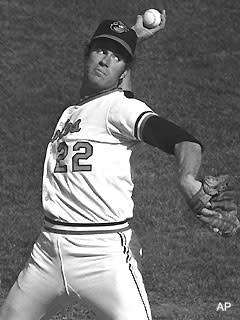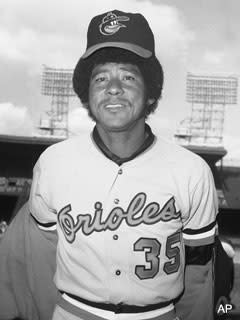Revisiting the 1971 Orioles and their four 20-game winners

With their acquisition of Cliff Lee(notes), the Philadelphia Phillies have put themselves in a position to field perhaps the best four-man rotation of all time. FanGraphs' Dave Cameron crunches the numbers and compares the 2011 Phillies to the 1993-1998 Braves and writes that the Phillies appear to come out on top:
"If there's a four-man rotation that has ever looked this dominant heading into a new year, I can't find it," he says.
However, Cameron doesn't discuss the other most famous four-man rotation in history: Earl Weaver's 1971 Baltimore Orioles, the last team to field four 20-game winners.*
*The only other team with four 20-game winners was the 1920 Chicago White Sox — it was the year after the Black Sox scandal, and following their confessions to a grand jury, the alleged conspirators were suspended by their owner at the end of the season, ending the team's chances of a pennant. Shortly thereafter, they were banned from baseball. Among them were Ed Cicotte and Lefty Williams, both of whom won 20 games in 1920, and then never played again.

The 1971 Orioles lost the World Series, but that put them in good company with some of the other dominant rotations in history. In 1970, the Birds had three 20-game winners, making the O's one of only four franchises in history to have back-to-back teams with three 20-game winners. The others were the 1903-1904 Boston Americans, 1904-1905 New York Giants, and 1951-1952 Cleveland Indians. That mighty group only won three World Series between them: Boston in 1903, New York in 1905, and Baltimore in 1970. The 1904 Series would have been between Boston and New York, but it was canceled at New York manager John McGraw's insistence. (That ploy may not be effective for the Phillies' opponents.) Still, Cleveland missed the World Series in 1951 and 1952. So Philadelphia shouldn't start printing its World Series tickets just yet.
The mainstays of the 1971 Orioles rotation were 25-year-old future Hall of Famer Jim Palmer, 28-year-old Dave McNally, and 34-year-old Mike Cuellar. The fourth 20-game winner was Pat Dobson, who is often an afterthought in discussions of the Oriole staff; he was only in Baltimore from 1971-1972, and after leaving Baltimore he never again won 20 games or posted an ERA under 3.00.
Palmer — sadly the lone surviving member of the quartet after Cuellar died this past April — became a Hall of Famer, but teammates McNally and Cuellar each spent a half-decade as some of the best pitchers in the league; Cuellar won the 1969 Cy Young Award, and in 1970, all three of them finished in the top five of the Cy Young voting, as McNally finished second, Cuellar fourth, and Palmer fifth behind Minnesota's Jim Perry. Though McNally never won the award, he finished in the top four each year from 1969-1971; Palmer later won Cy Youngs in 1973, 1975 and 1976.
Like Cliff Lee, Mike Cuellar peaked late. His first full season came at the age of 29 — the same age that Lee was when he won the Cy Young and established himself as one of the most dominant pitchers in baseball. Cuellar won his Cy when he was 32, and was one of the better pitchers in the league throughout his 30s. By contrast, McNally was finished by the age of 32, and Palmer's last full season came at the age of 36. All of their arms were pretty ragged after all the innings they threw; each man averaged more than 250 innings a season between 1969 and 1973. McNally had suffered for years from a sore arm and shoulder, and he left the game in 1975 after refusing to sign his contract, and in doing so, challenging the "reserve clause" that underpinned baseball's contract system before the dawn of free agency.

All those innings came because the Orioles featured a four-man rotation. In 1971, Cuellar (right), Dobson and Palmer each had 37 or 38 starts, while McNally had 30. (By contrast, in 2010, Cy Young Award winner Roy Halladay(notes) and Cole Hamels(notes) had 33 starts, Roy Oswalt(notes) had 32, and Cliff Lee had just 28.) So their win totals are inflated by their increased number of starts, and their ERAs are deflated by virtue of their pitching in an era when far fewer runs scored — last year, NL teams averaged 4.33 runs a game, while in 1971, AL teams averaged 3.87 runs a game.
So, while Cuellar, McNally and Palmer were as dominant as any pitchers in the league, they didn't stand apart from their peers quite as forcefully as the Phillies' foursome did last year, as Halladay and Lee both starred in the playoffs, and Oswalt was virtually untouchable down the stretch. Wins Above Replacement analysis reveals the disconnect: The 1971 Orioles combined for 13 WAR, while the four prospective starters of the 2011 Phillies combined for 21 WAR last year.
But, of course, it's all academic until the season starts.

